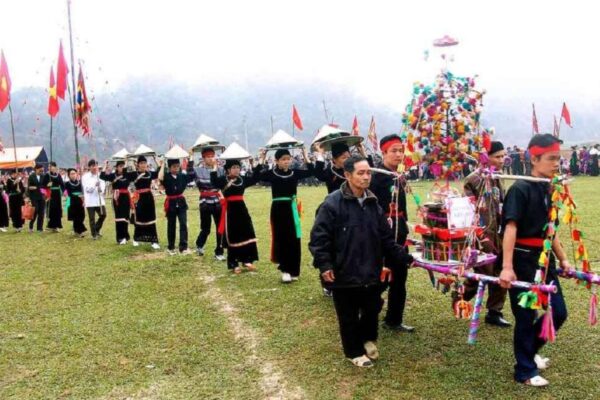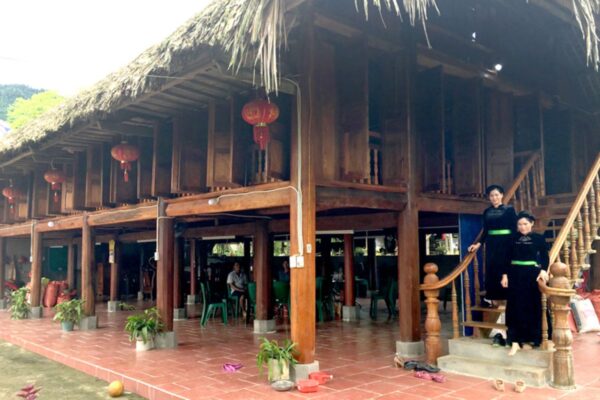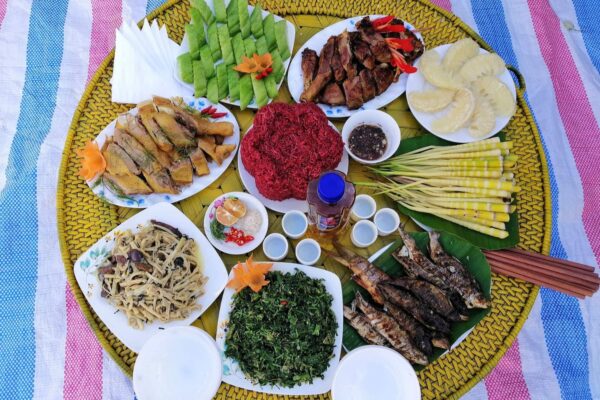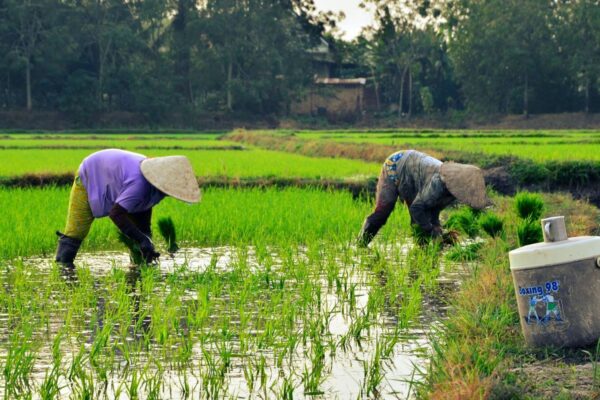The Tay people, one of the ethnic minorities in Vietnam, have a rich and ancient historical origin. They appeared in Vietnam since the end of the first millennium BC and are considered one of the earliest owners of ancient Vietnam. With their existence and development over thousands of years, the Tay people have created a unique and diverse culture. Find out all the information about the life and beliefs of the Tay people with Loka Ha Giang in the article below.
Geographical Location
Nestled amidst the awe-inspiring landscapes of Ha Giang city in Vietnam, lies the fascinating abode of the Tay people. Renowned for their rich cultural heritage and unwavering connection to nature, the Tay community has thrived in this mesmerizing region for generations.
Venturing into the heart of Ha Giang, one is immediately captivated by the breathtaking vistas that surround the traditional villages of the Tay people. Here, lush terraced rice fields cascade down rolling hills, as if a painter’s brush has artistically draped the landscape with vibrant hues of green and gold. The rhythm of daily life harmonizes with the ebb and flow of nature, as the Tay people diligently engage in the nurturing of their lands, cultivating rice, crops, and tending to their cherished livestock.

Beyond the picturesque rural scenes, the Tay people’s cultural heritage unfurls like a tapestry, with vibrant threads of age-old traditions, colorful festivals, and soulful folk art forms. Their ancestral wisdom echoes through captivating songs and storytelling, which carry the essence of their identity and beliefs. Each celebration is a time-honored spectacle, weaving together dance, music, and traditional attire, immersing visitors in a sensory experience unlike any other.
Yet, amidst the celebration of tradition, Ha Giang also embraces modernity, where the Tay people skillfully adapt to the changing times. The thriving tourism sector opens a window to a world where visitors can delve into the heart of the Tay culture, exploring local handicrafts, savoring authentic delicacies, and partaking in the warmth of Tay hospitality.
Population and Language of the Tay People
The Tay people, as recorded in the comprehensive 2021 ethnic minority survey, boast a population exceeding 2 million individuals, predominantly residing in the Eastern and Northern provinces of the country. Their presence spans far and wide, reflecting the richness and antiquity of their unique cultural heritage, which has permeated throughout the nation.

Embedded within the Tay-Thai language group, an offshoot of the broader Tai-Kadai language family, the official language of the Tay people is a marvel of complexity and diversity. This intricate linguistic system not only mirrors the cultural multiplicity within the Tay community but also serves as an invaluable conduit for daily communication. Beyond its functional use, the Tay language assumes a profound role in knowledge dissemination, tradition perpetuation, and the preservation of their cherished cultural values. It stands as an essential cornerstone in the tapestry of Tay identity and heritage.
Main Characteristics of the Tay People
Religion and Beliefs

Religion and beliefs hold a significant and intricate place in the spiritual realm of the Tay people, weaving a rich tapestry of diverse folk beliefs. Within their cultural milieu, a myriad of devotions manifests, ranging from venerating ancestors and paying homage to revered figures like Lady Mu, Buddha, and the Kitchen Gods within the confines of their homes, to engaging in communal worship of land deities and other celestial beings. This mosaic of beliefs stands as a vital pillar of the religious culture observed by the Tay, harmoniously blending their profound folk traditions with the tenets of Buddhism. The amalgamation of these spiritual practices reflects the profound spiritual legacy that defines the unique and captivating religious landscape of the Tay community.
Housing
The traditional housing of the Tay people often comprises stilt houses, half-stilt half-earth houses, and defensive houses. These types of houses are built to suit the natural conditions and terrain of the land where the Tay people reside.

- Stilt houses: This is a prevalent architectural style in the Tay people’s culture. Stilt houses are constructed on sturdy columns, creating a space beneath the floor level for livestock husbandry or storing agricultural produce. These stilt houses serve to protect the Tay people from natural disasters such as floods and earthquakes.
- Half-stilt half-earth houses: This type of house combines a raised floor with a portion built on the ground. The elevated part is used for daily activities and living quarters, while the lower section is utilized for cultivating crops or as a space for livestock. This design helps save space and maximizes resource utilization.
- Defensive houses: These houses are built with the purpose of withstanding enemy attacks. They often feature robust architecture, employing sturdy materials like wood and stone. Doors and windows are designed for easy closure to protect the family from external threats.
Thus, constructing these traditional houses reflects the Tay people’s harmony with nature and their ability to adapt to challenging living conditions in their region. These unique architectural features and traditional building techniques also showcase the cultural diversity and richness of the Tay community.
Clothing

The traditional clothing of the Tay people showcases a rich cultural heritage, with its prominent use of black chamois fabric adorned with subtle floral embellishments. This ancient and distinctive tradition is deeply rooted in the Tay community, exemplifying their exquisite taste and embracing a fashion style characterized by delicacy and simplicity. The garments, meticulously crafted, not only serve as a form of cultural expression but also carry a profound historical significance, preserving the unique identity of the Tay people through generations.
Cuisine

The culinary traditions of the Tay people are a treasure trove of unique and diverse characteristics. At the heart of their dishes lies the beloved sticky rice, which serves as a staple ingredient for an array of delightful delicacies, ranging from delectable cakes and nourishing porridge to mouthwatering sticky rice-based dishes. The Tay people’s culinary artistry goes beyond taste, as their distinctive flavors and intricate processing methods have endowed their cuisine with a profound cultural significance. Each dish tells a story of generations past, reflecting the people’s deep-rooted connection to their land and the bountiful gifts it provides. Through their culinary heritage, the Tay people proudly share their history, customs, and a warm invitation to experience the essence of their vibrant culture.
Art
The artistic heritage of the Tay people is a captivating tapestry that enriches their cultural legacy. Within their vibrant traditions, a myriad of folk art forms flourish, each exuding its own unique charm and significance. The mellifluous melodies of Luon singing, the soul-stirring cadences of Then singing, the captivating rhythms of Quan Lang singing, the expressive verses of Vi singing, the soothing lullabies of Ru singing, and the resounding beats of Dong Dao singing all come together to form an intricate mosaic of artistic expression.

These awe-inspiring art forms not only showcase the diverse talents of the Tay people but also serve as vivid reflections of their ethnic identity, embodying the very essence of their emotions and timeless customs. Passed down through generations, these arts serve as an eloquent language that speaks of the Tay people’s heritage, forging a profound connection between the past, present, and future. Whether through vibrant celebrations or soulful storytelling, the traditional art of the Tay people continues to thrive as a living testament to their rich cultural heritage, captivating hearts and minds alike with its sheer beauty and captivating tales.
Education
Education holds a paramount significance in the lives of the Tay people, reflecting their deep commitment to personal and communal growth. Remarkably, the literacy rate among Tay individuals aged 15 and above, who possess the ability to read and write in Vietnamese, stands at an impressive 94.9%. This remarkable statistic underscores the Tay community’s profound interest in and dedication to education, with a relentless pursuit of knowledge that fuels their aspirations.

Moreover, alongside their zeal for education, the Tay people actively preserve and nurture their treasured traditional crafts. Through generations of skillful artisans, they continue to breathe life into time-honored crafts, such as the intricate art of weaving, the artful dyeing of chamois, the meticulous tile-making, and the finesse of woodworking. Each craft carries within it a rich tapestry of stories, wisdom, and cultural heritage, connecting the present with a cherished past.
Through the combination of a strong educational ethos and a steadfast commitment to preserving their unique cultural heritage, the Tay people embrace the future with a sense of resilience and pride. Their passion for education and traditional craftsmanship stands as a testament to the enduring spirit of this remarkable community, as they navigate the ever-changing tides of time while staying grounded in their cherished traditions.
Economy

When it comes to the economy, the resourceful Tay people have adeptly harnessed and nurtured the bountiful natural resources of their land. Agriculture stands as their primary livelihood, encompassing an array of activities such as rice cultivation, the cultivation of various crops, and skillful livestock farming. The deep-rooted connection to the land is evident in their farming practices, which are imbued with time-honored techniques and wisdom passed down through generations.
In recent times, tourism has emerged as a pivotal player in the local economy, showcasing the Tay people’s ingenuity in the exploitation and development of their cultural and natural treasures. Visitors are drawn to the enchanting allure of the region, captivated by its unique traditions, colorful festivals, and captivating folklore. Amidst stunning landscapes and picturesque villages, cultural tourist attractions thrive, unveiling the hidden gems of Tay art, cuisine, and traditional craftsmanship.

This harmonious blend of agrarian pursuits and blossoming tourism ventures reflects the adaptability and resilience of the Tay people, as they skillfully navigate between preserving their age-old agricultural heritage and embracing the opportunities brought forth by the growing tourism sector. The tapestry of their economic landscape is woven with a delicate interplay between tradition and modernity, making it a captivating journey for both the Tay people themselves and the curious travelers who venture to experience the magic of their world.
The Tay people, with their rich historical origins, diverse cultural and living characteristics, have created a unique cultural heritage. From religion, housing, clothing, cuisine, art, education, and economic conditions, all factors contribute to the formation and development of the unique culture of the Tay people.
Please view more interesting articles:
- The Mhong People – The Essence of Cultural Heritage and Traditional Legacy
- Ha Giang Loop – An unmissable journey when traveling in Vietnam

My name is Giap Van Hai, I am a travel enthusiast and always want to share the beauty of Ha Giang with everyone. With a deep love for the mountains and the typical culture of Ha Giang people, I decided to establish Loka Ha Giang – a website specializing in Ha Giang tourism services. We provide travel services such as Ha Giang Loop, Ha Giang Trekking, Ha Giang Easyrider
